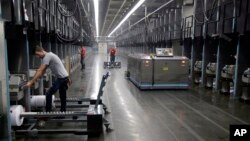President Donald Trump is presenting a skewed picture of the decline of manufacturing in making his case for import penalties that could spark a trade war.
A look at his latest statement on the subject as he prepares to impose heavy tariffs on foreign steel and aluminum:
TRUMP: “From Bush 1 to present, our Country has lost more than 55,000 factories, 6,000,000 manufacturing jobs and accumulated Trade Deficits of more than 12 Trillion Dollars. Last year we had a Trade Deficit of almost 800 Billion Dollars. Bad Policies & Leadership. Must WIN again!” — tweet Wednesday.
THE FACTS: Trump persistently miscasts the trade balance, citing the U.S. deficit in goods and ignoring the U.S. surplus in services. The actual trade deficit last year was $566 billion.
As for manufacturing, Trump leaves out what is widely regarded as the main reason for the decline in factory jobs: automation and other efficiencies. Trade is certainly a factor as well.
He’s in the ballpark when referring to how many factory jobs have been lost since January 1989, when George H.W. Bush became president. The number he cites as 6 million is actually 5.5 million, according to the Labor Department.
What he doesn’t say, though, is that despite the loss of those 5.5 million factory jobs, the U.S. economy overall has added a net total of about 40.6 million jobs in that time. Incomes from those jobs have paid for the imported goods that have added to U.S. trade deficits.
Historical context
He also does not offer a larger historical context. The U.S. lost 1.6 million manufacturing jobs in the decade before Bush, a pace of decline only slightly lower than that during the 30-year period cited by Trump.
Factory jobs dropped during the severe downturns of the early 1980s, stayed fairly stable until about 2000, then dropped sharply. Economists are divided about why.
The big drop after 2000 roughly coincides with China’s entry into the World Trade Organization in December 2001, which meant U.S. manufacturers increasingly competed with China and gained an incentive to move factories there. Some economists put the most blame on technology.
Ball State University’s Center for Business and Economic Research, for instance, found in a 2015 study that trade accounted for just 13 percent of factory job losses, with technology devouring most of the rest.









